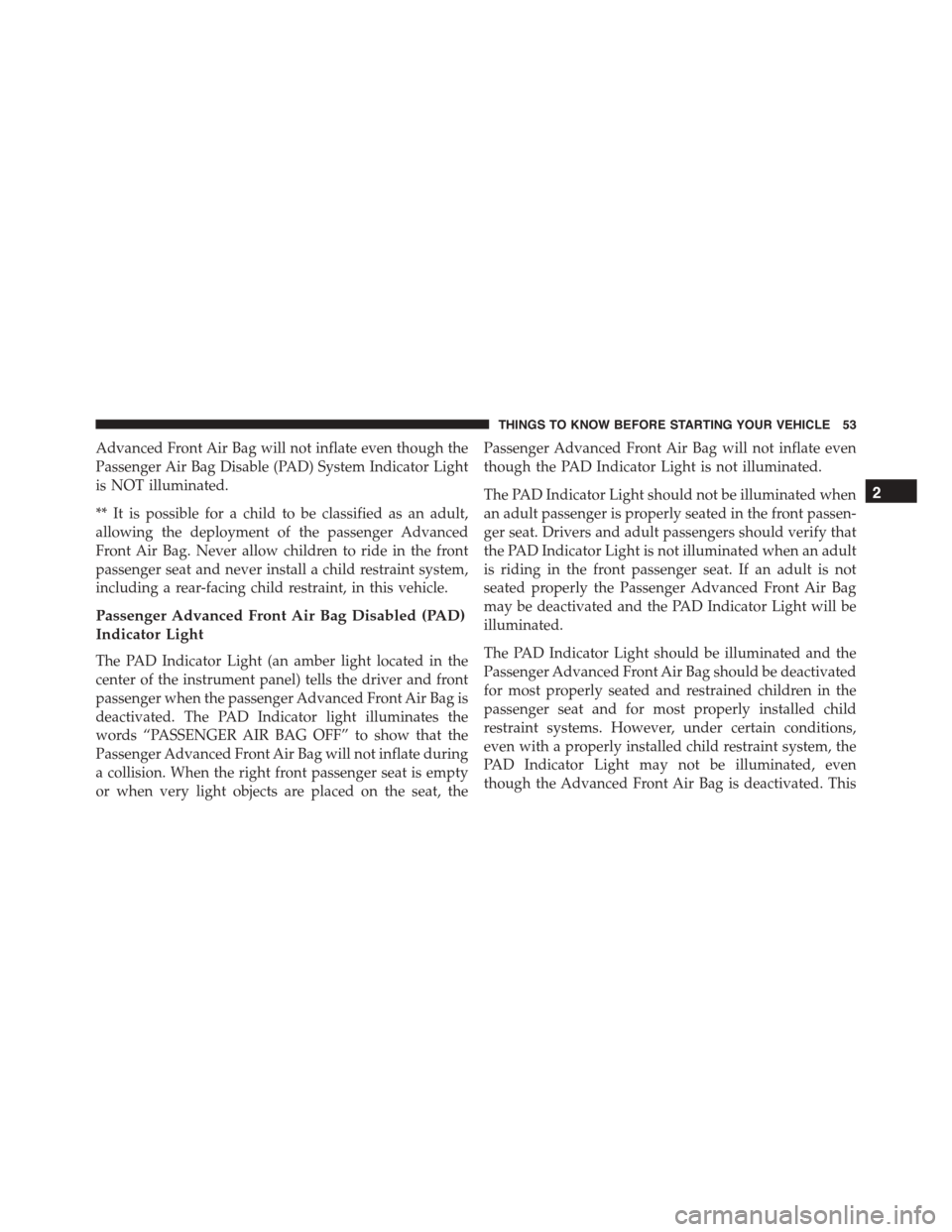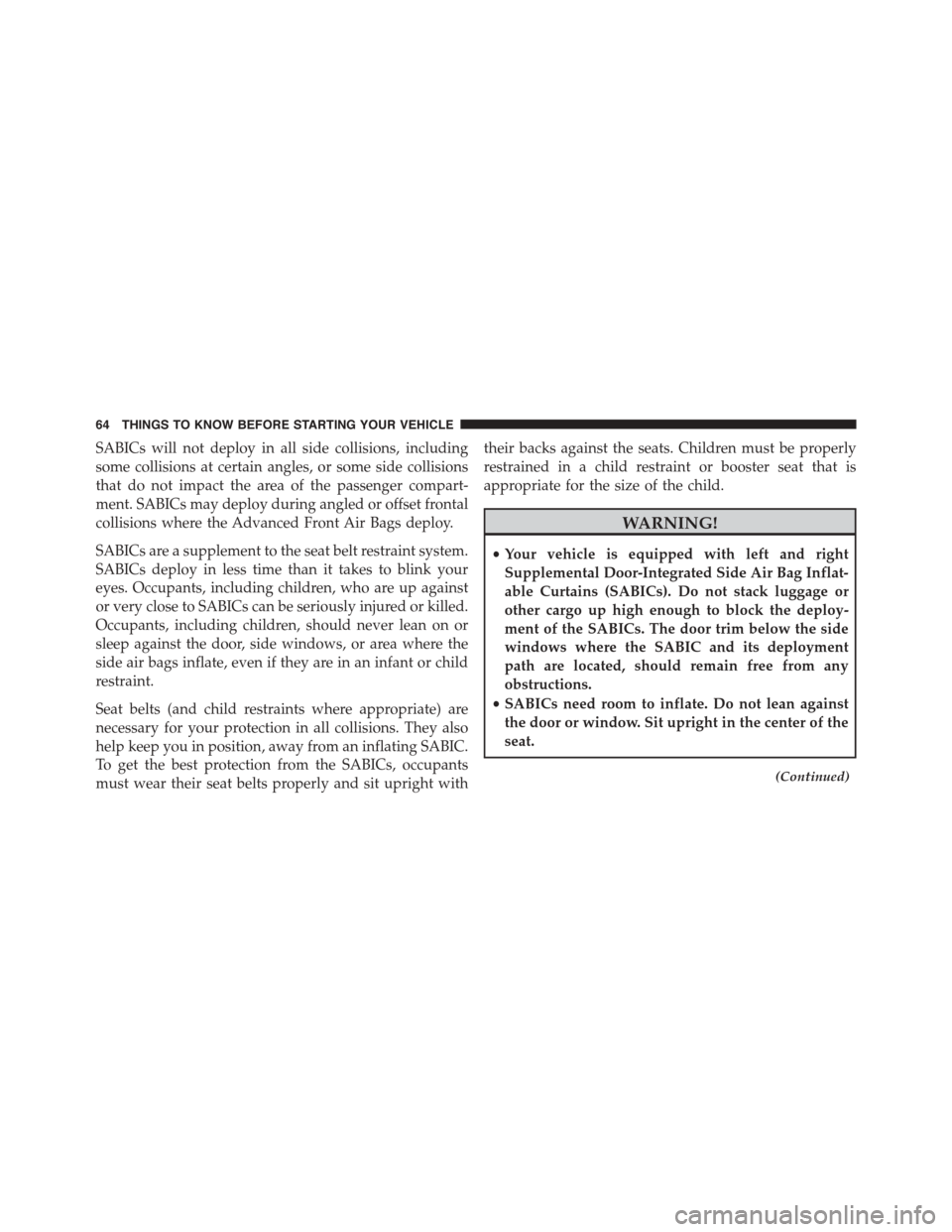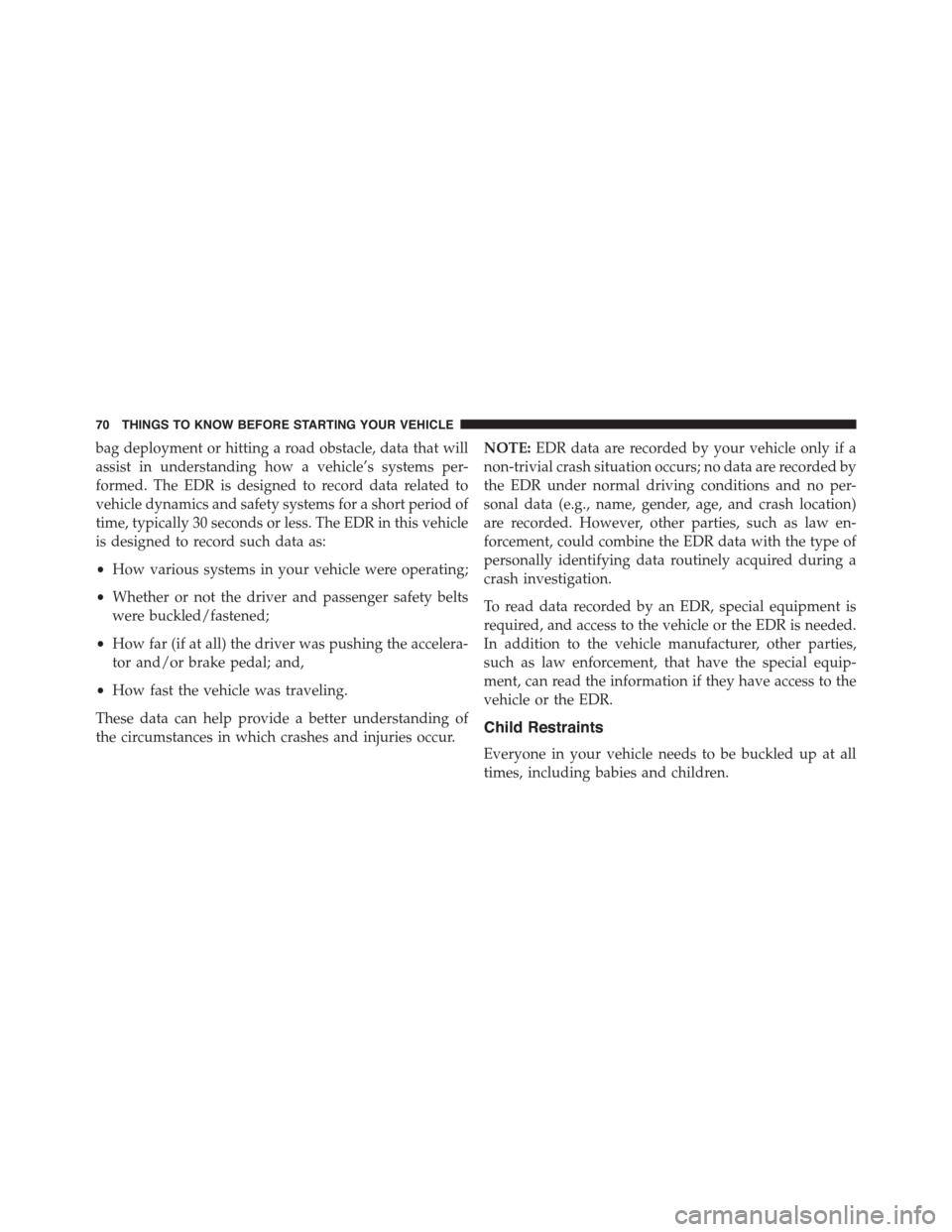2015 DODGE VIPER child restraint
[x] Cancel search: child restraintPage 51 of 400

way as the air bags inflate to their full size. The Advanced
Front Air Bags fully inflate in less time than it takes to
blink your eyes. The air bags then quickly deflate while
helping to restrain the driver and front passenger.
Occupant Classification System (OCS) - Front
Passenger Seat
The OCS is part of a Federally regulated safety system for
this vehicle. It is designed to deactivate the front passen-
ger Advanced Front Air Bag for an unoccupied seat and
for occupants classified in a category other than a prop-
erly seated adult. This could be a child, teenager, or even
an adult.
WARNING!
•Never place a rear-facing child restraint in front of
an air bag. A deploying Passenger Advanced Front
Air Bag can cause death or serious injury to a child
12 years or younger, including a child in a rear-
facing child restraint.
•Only use a rear-facing child restraint in a vehicle
with a rear seat.
The Occupant Classification System (OCS) consists of the
following:
•Occupant Restraint Controller (ORC)
•Occupant Classification Module (OCM) located under-
neath the front passenger seat
•Bladder located beneath the passenger seat cushion
foam
2
THINGS TO KNOW BEFORE STARTING YOUR VEHICLE 49
Page 53 of 400

The Passenger Advanced Front Air Bag may be deacti-
vated if the OCS estimates that:
•The front passenger seat is unoccupied or has very
light objects on it
•The front passenger seat is occupied by a rear-facing
child restraint
•The front passenger seat is occupied by a child,
including a child seated in a forward-facing child
restraint or booster seat
•The front passenger seat is occupied by a small pas-
senger, including a small adult
•The front passenger is not properly seated or his/her
weight is taken off of the seat for a period of time
Seated Properly
2
THINGS TO KNOW BEFORE STARTING YOUR VEHICLE 51
Page 55 of 400

Advanced Front Air Bag will not inflate even though the
Passenger Air Bag Disable (PAD) System Indicator Light
is NOT illuminated.
** It is possible for a child to be classified as an adult,
allowing the deployment of the passenger Advanced
Front Air Bag. Never allow children to ride in the front
passenger seat and never install a child restraint system,
including a rear-facing child restraint, in this vehicle.
Passenger Advanced Front Air Bag Disabled (PAD)
Indicator Light
The PAD Indicator Light (an amber light located in the
center of the instrument panel) tells the driver and front
passenger when the passenger Advanced Front Air Bag is
deactivated. The PAD Indicator light illuminates the
words “PASSENGER AIR BAG OFF” to show that the
Passenger Advanced Front Air Bag will not inflate during
a collision. When the right front passenger seat is empty
or when very light objects are placed on the seat, the
Passenger Advanced Front Air Bag will not inflate even
though the PAD Indicator Light is not illuminated.
The PAD Indicator Light should not be illuminated when
an adult passenger is properly seated in the front passen-
ger seat. Drivers and adult passengers should verify that
the PAD Indicator Light is not illuminated when an adult
is riding in the front passenger seat. If an adult is not
seated properly the Passenger Advanced Front Air Bag
may be deactivated and the PAD Indicator Light will be
illuminated.
The PAD Indicator Light should be illuminated and the
Passenger Advanced Front Air Bag should be deactivated
for most properly seated and restrained children in the
passenger seat and for most properly installed child
restraint systems. However, under certain conditions,
even with a properly installed child restraint system, the
PAD Indicator Light may not be illuminated, even
though the Advanced Front Air Bag is deactivated. This
2
THINGS TO KNOW BEFORE STARTING YOUR VEHICLE 53
Page 56 of 400

can occur if the child restraint is lighter than the lightest
weight necessary to illuminate the PAD Indicator Light.
NEVER assume the Passenger Advanced Front Air Bag is
deactivated unless the PAD Indicator Light is illuminated
with the words “PASSENGER AIR BAG OFF.”
If The Pad Indicator Light Is Illuminated For An
Adult Passenger:
If an adult passenger is seated in the passenger seat and
the PAD Indicator Light is illuminated, the passenger
may be sitting improperly. Follow the steps below to
allow the OCS to detect the adult passenger ’s seated
weight to activate the Passenger Advanced Front Air Bag:
1. Turn off the vehicle and have the adult passenger step
out of the vehicle.
2. Remove any extra materials from the passenger seat,
such as cushions, pads, seat covers, seat massagers,
blankets, extra clothing, etc.
3. Place the seatback in the full upright position.
4. Have the adult passenger sit upright in the passenger
seat, sitting in the center of the seat cushion, with the
passenger ’s legs fully extended.
5. Restart the vehicle and have the passenger remain in
this sitting position for two to three minutes after
restarting the vehicle.
54 THINGS TO KNOW BEFORE STARTING YOUR VEHICLE
Page 57 of 400

WARNING!
•If the PAD Indicator Light remains illuminated for
an adult passenger, have an authorized dealer ser-
vice the air bag system immediately. Failure to do
so may cause serious injury or death. If the PAD
Indicator Light is illuminated with the words
“PASSENGER AIR BAG OFF” the Passenger Ad-
vanced Front Air Bag will not inflate in the event of
a collision.
•Never place a rear facing infant seat in front of a
Passenger Advanced Front Air Bag. A deploying
passenger Advanced Front Air Bag can cause death
or serious injury to a child 12 years or younger,
including a child in a rear-facing child restraint.
•Only use a rear-facing child restraint in a vehicle
with a rear seat.
Lighter Weight Passengers (Including Small
Adults)
When a lighter weight passenger, including a small adult,
occupies the passenger seat, the Passenger Advanced
Front Air Bag may be deactivated. Therefore, the Passen-
ger Advanced Front Air Bag may or may not deploy for
a lighter weight passenger, including a small adult (de-
pending on size), who is seated in the front passenger
seat. This does not mean that the OCS is working
improperly.
The driver and passenger must always pay attention to
the Passenger Air Bag Disable (PAD) System. The PAD
Indicator Light tells you whether the Passenger Ad-
vanced Front Air Bag is activated or deactivated. If the
PAD Indicator Light is illuminated with the words “PAS-
SENGER AIR BAG OFF,” the Passenger Advanced Front
Air Bag may not inflate in the event of a collision. If the
2
THINGS TO KNOW BEFORE STARTING YOUR VEHICLE 55
Page 65 of 400

The SABICs may help reduce the risk of partial or
complete ejection of vehicle occupants through side
windows in certain side impact events.
The SABICs deploy upward, covering the side windows.
An inflating SABIC pushes the outside edge of the trim
out of the way and covers the window. The SABICs
inflate with enough force to injure you if you are not
belted and seated properly, or if items are positioned in
the area where the SABICs inflate. Children are at an
even greater risk of injury from a deploying air bag.
SABICs are designed to activate in certain side impacts.
The Occupant Restraint Controller (“ORC”) determines
whether the deployment of the SABIC in a particular
impact event is appropriate, based on the severity and
type of collision. The side impact sensors aid the ORC in
determining the appropriate response to impact events.
The system is calibrated to deploy the SABIC on the
impact side of the vehicle during impacts that require
SABIC occupant protection. In side impacts, the SABICs
deploy independently; a left side impact deploys the left
side SABIC only and a right-side impact deploys the
right side SABIC only. Vehicle damage by itself is not a
good indicator of whether or not SABICs should have
deployed.
Supplemental Door-Integrated Side Air Bag Label
2
THINGS TO KNOW BEFORE STARTING YOUR VEHICLE 63
Page 66 of 400

SABICs will not deploy in all side collisions, including
some collisions at certain angles, or some side collisions
that do not impact the area of the passenger compart-
ment. SABICs may deploy during angled or offset frontal
collisions where the Advanced Front Air Bags deploy.
SABICs are a supplement to the seat belt restraint system.
SABICs deploy in less time than it takes to blink your
eyes. Occupants, including children, who are up against
or very close to SABICs can be seriously injured or killed.
Occupants, including children, should never lean on or
sleep against the door, side windows, or area where the
side air bags inflate, even if they are in an infant or child
restraint.
Seat belts (and child restraints where appropriate) are
necessary for your protection in all collisions. They also
help keep you in position, away from an inflating SABIC.
To get the best protection from the SABICs, occupants
must wear their seat belts properly and sit upright with
their backs against the seats. Children must be properly
restrained in a child restraint or booster seat that is
appropriate for the size of the child.
WARNING!
•Your vehicle is equipped with left and right
Supplemental Door-Integrated Side Air Bag Inflat-
able Curtains (SABICs). Do not stack luggage or
other cargo up high enough to block the deploy-
ment of the SABICs. The door trim below the side
windows where the SABIC and its deployment
path are located, should remain free from any
obstructions.
•SABICs need room to inflate. Do not lean against
the door or window. Sit upright in the center of the
seat.
(Continued)
64 THINGS TO KNOW BEFORE STARTING YOUR VEHICLE
Page 72 of 400

bag deployment or hitting a road obstacle, data that will
assist in understanding how a vehicle’s systems per-
formed. The EDR is designed to record data related to
vehicle dynamics and safety systems for a short period of
time, typically 30 seconds or less. The EDR in this vehicle
is designed to record such data as:
•How various systems in your vehicle were operating;
•Whether or not the driver and passenger safety belts
were buckled/fastened;
•How far (if at all) the driver was pushing the accelera-
tor and/or brake pedal; and,
•How fast the vehicle was traveling.
These data can help provide a better understanding of
the circumstances in which crashes and injuries occur.
NOTE:EDR data are recorded by your vehicle only if a
non-trivial crash situation occurs; no data are recorded by
the EDR under normal driving conditions and no per-
sonal data (e.g., name, gender, age, and crash location)
are recorded. However, other parties, such as law en-
forcement, could combine the EDR data with the type of
personally identifying data routinely acquired during a
crash investigation.
To read data recorded by an EDR, special equipment is
required, and access to the vehicle or the EDR is needed.
In addition to the vehicle manufacturer, other parties,
such as law enforcement, that have the special equip-
ment, can read the information if they have access to the
vehicle or the EDR.
Child Restraints
Everyone in your vehicle needs to be buckled up at all
times, including babies and children.
70 THINGS TO KNOW BEFORE STARTING YOUR VEHICLE